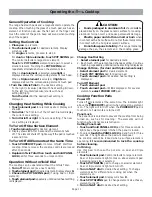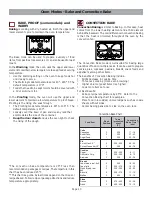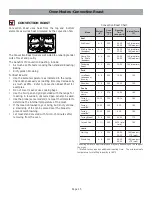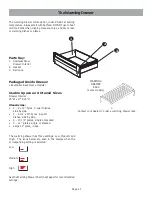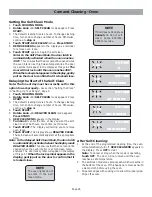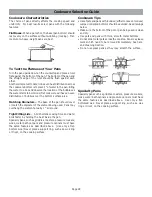
Page 14
Oven Modes - Broil and Convection Broil
CONVECTION BROIL
BROIL
Broiling uses intense heat radiated from the upper element: Convection Broil is similar to Broil. It combines the intense
heat from the upper element with heat circulated by the
convection fan:
The Broil mode is best suited to cooking thin, tender cuts of
meat (1” or less), poultry and fish. It can also be used to
brown breads and casseroles.
The benefits of Broiling include:
•
Fast and efficient cooking
•
Cooking without the addition of fats or liquids
•
Browning as the food cooks
For Best Results:
•
Preheat oven 3-4 minutes
•
Steaks and Chops should be at least 3/4” thick
•
Brush fish and poultry with butter or oil to prevent sticking
•
Use the broil pan and grid included with your range
•
Do not cover the broiler grid with foil. It is designed to
drain fats and oils away from the cooking surface to
prevent smoking and spattering
•
Turn meats once halfway through the recommended
cooking time (see Broil Chart for examples).
•
When top browning casseroles, use only metal or glass
ceramic dishes such as Corningware®.
•
Never use heat-proof glass (Pyrex®); they cannot tolerate
the high temperature.
The Convection Broil mode is well suited for cooking thicker,
tender cuts of meat, poultry and fish. Convection Broil is
typically not recommended for browning breads, casseroles
and other foods.
The benefits of Convection Broiling, in addition to the benefits
of standard broiling, include:
•
Faster cooking than standard Broiling
For Best Results:
•
Preheat oven 3-4 minutes
•
Meats should be at least 1 1/2” thick
•
Turn meats once halfway through the cooking time (See
Convection Broil Chart for examples)
•
Use the broil pan and grid included with your range
•
Do not cover the broiler grid with foil. It is designed to
drain fats and oils away from the cooking surface to
prevent smoking and spattering
•
Salt after cooking
ALWAYS BROIL WITH THE DOOR CLOSED
ALWAYS CONVECTION BROIL WITH THE DOOR CLOSED
Note: The only heat setting for the Convection Broil setting is High
Convection Broil Chart
Broil Chart
d
n
a
d
o
o
F
s
s
e
n
k
c
i
h
T
k
c
a
R
n
o
i
t
i
s
o
P
l
i
o
r
B
g
n
i
t
t
e
S
l
a
n
r
e
t
n
I
.
p
m
e
T
)
F
°
(
e
m
i
T
1
e
d
i
S
*
)
n
i
m
(
e
m
i
T
2
e
d
i
S
*
)
n
i
m
(
f
e
e
B
)
"
1
-
"
4
/
3
(
k
a
e
t
S
e
r
a
R
m
u
i
d
e
M
m
u
i
d
e
M
ll
e
W
s
r
e
g
r
u
b
m
a
H
)
"
1
-
"
4
/
3
(
ll
e
W
5
5
5
4
*
h
g
i
H
h
g
i
H
h
g
i
H
h
g
i
H
5
4
1
0
6
1
0
7
1
0
6
1
8
-
7
9
-
8
1
1
-
9
5
1
-
2
1
7
-
6
9
-
6
0
1
-
7
8
-
7
y
r
t
l
u
o
P
)
n
i
-
e
n
o
b
(
t
s
a
e
r
B
4
*
w
o
L
0
7
1
0
2
-
8
1
9
1
-
8
1
k
r
o
P
)
"
1
(
s
p
o
h
C
k
r
o
P
h
s
e
r
f
-
e
g
a
s
u
a
S
)
"
2
/
1
(
e
c
il
S
m
a
H
4
3
5
h
g
i
H
h
g
i
H
h
g
i
H
0
6
1
0
6
1
0
6
1
0
1
-
9
0
1
-
8
4
-
3
9
-
8
9
-
7
3
-
2
d
o
o
f
a
e
S
"
1
,
s
t
e
l
i
F
h
s
i
F
d
e
r
e
t
t
u
B
4
w
o
L
k
o
o
C
l
i
t
n
u
e
u
q
a
p
o
s
e
k
a
l
f
&
y
l
i
s
a
e
k
r
o
f
h
t
i
w
7
-
6
O
D
T
O
N
N
R
U
T
b
m
a
L
)
"
1
(
s
p
o
h
C
e
r
a
R
m
u
i
d
e
M
m
u
i
d
e
M
ll
e
W
5
5
5
h
g
i
H
h
g
i
H
h
g
i
H
5
4
1
0
6
1
0
7
1
7
-
5
9
-
8
1
1
-
9
7
-
6
8
-
6
9
-
8
d
a
e
r
B
"
1
,
d
a
e
r
B
c
il
r
a
G
s
e
c
il
s
5
h
g
i
H
4
-
2
d
n
a
d
o
o
F
s
s
e
n
k
c
i
h
T
k
c
a
R
n
o
i
t
i
s
o
P
l
i
o
r
B
g
n
i
t
t
e
S
l
a
n
r
e
t
n
I
.
p
m
e
T
)
F
°
(
e
m
i
T
e
d
i
S
1
*
)
n
i
m
(
e
m
i
T
e
d
i
S
2
*
)
n
i
m
(
f
e
e
B
)
e
r
o
m
r
o
"
½
-
1
(
k
a
e
t
S
e
r
a
R
m
u
i
d
e
M
m
u
i
d
e
M
ll
e
W
e
r
o
m
(
s
r
e
g
r
u
b
m
a
H
)
"
1
n
a
h
t
ll
e
W
4
4
4
4
*
h
g
i
H
h
g
i
H
h
g
i
H
h
g
i
H
5
4
1
0
6
1
0
7
1
0
6
1
9
-
8
1
1
-
0
1
3
1
-
2
1
1
1
-
9
8
-
7
0
1
-
9
2
1
-
1
1
9
-
7
y
r
t
l
u
o
P
s
r
e
t
r
a
u
Q
n
e
k
c
i
h
C
4
h
g
i
H
0
8
1
)
h
g
i
h
t
(
0
7
1
)
t
s
a
e
r
b
(
5
1
-
2
1
1
1
-
9
k
r
o
P
r
o
"
¼
1
(
s
p
o
h
C
k
r
o
P
)
e
r
o
m
h
s
e
r
f
-
e
g
a
s
u
a
S
4
4
h
g
i
H
h
g
i
H
0
6
1
0
6
1
0
1
-
8
7
-
6
9
-
7
5
-
4
*(Broiling and Convection broiling times are approximate and
may vary slightly. Times are based on cooking with a preheated
broil element.
DO
NOT
TURN












